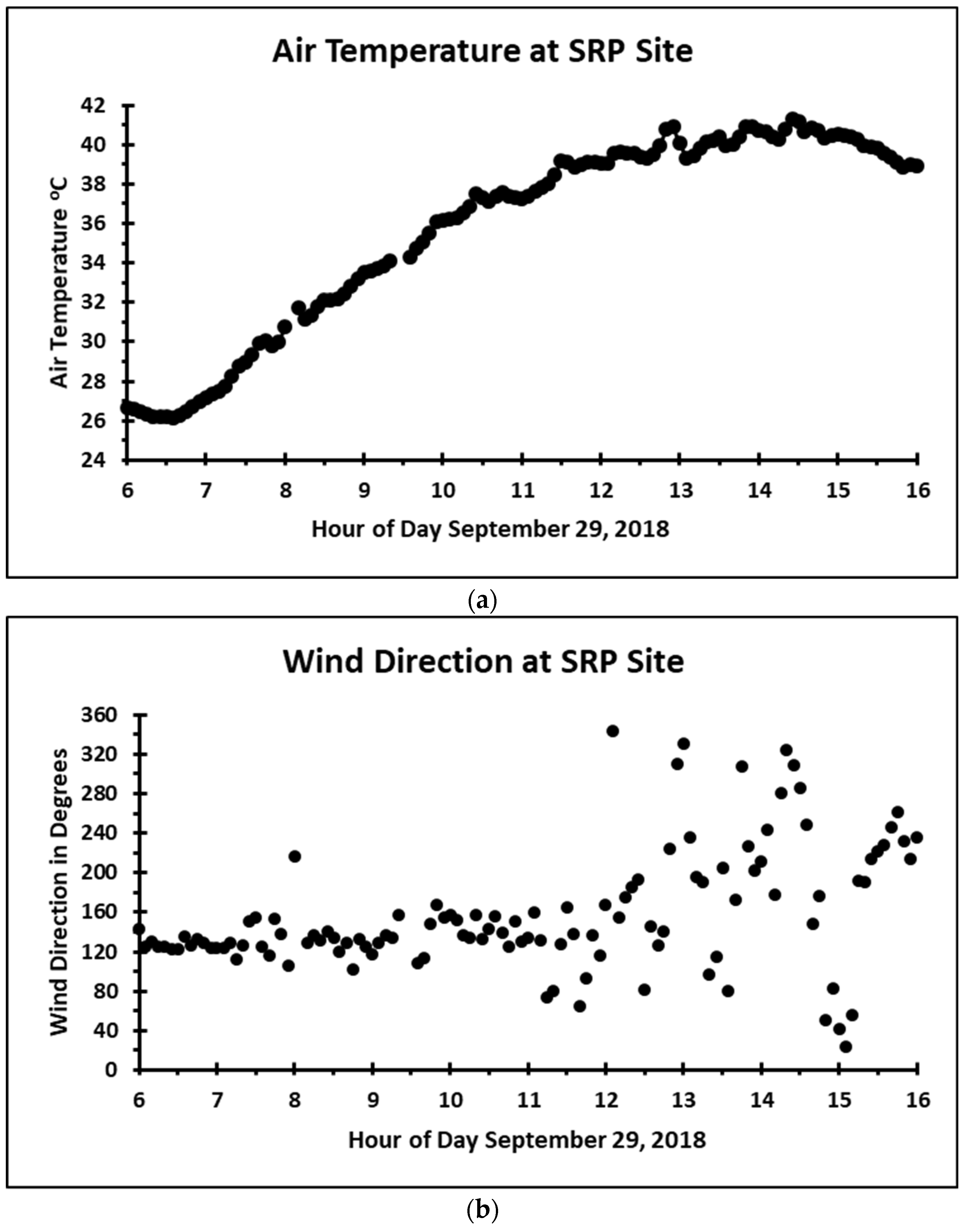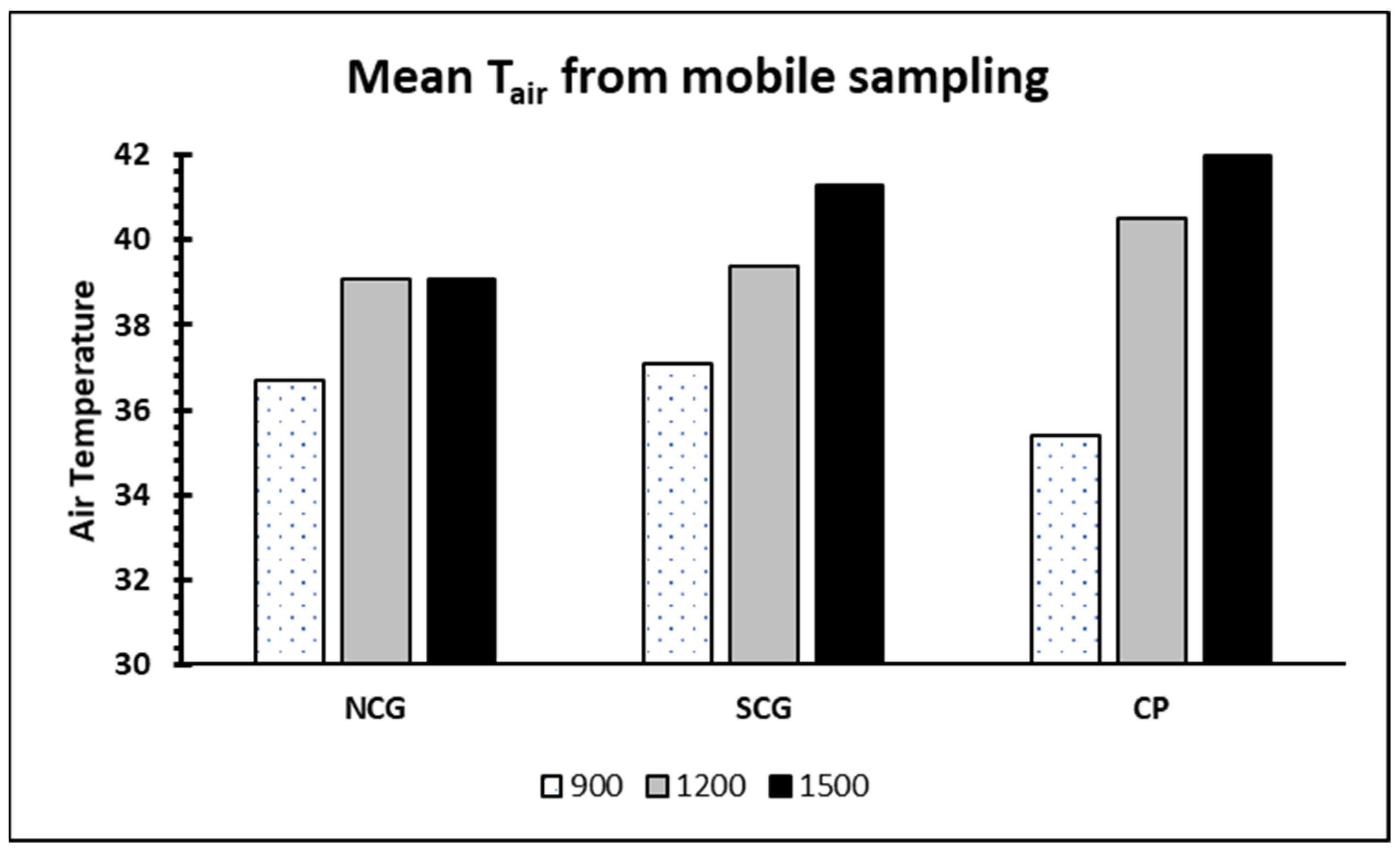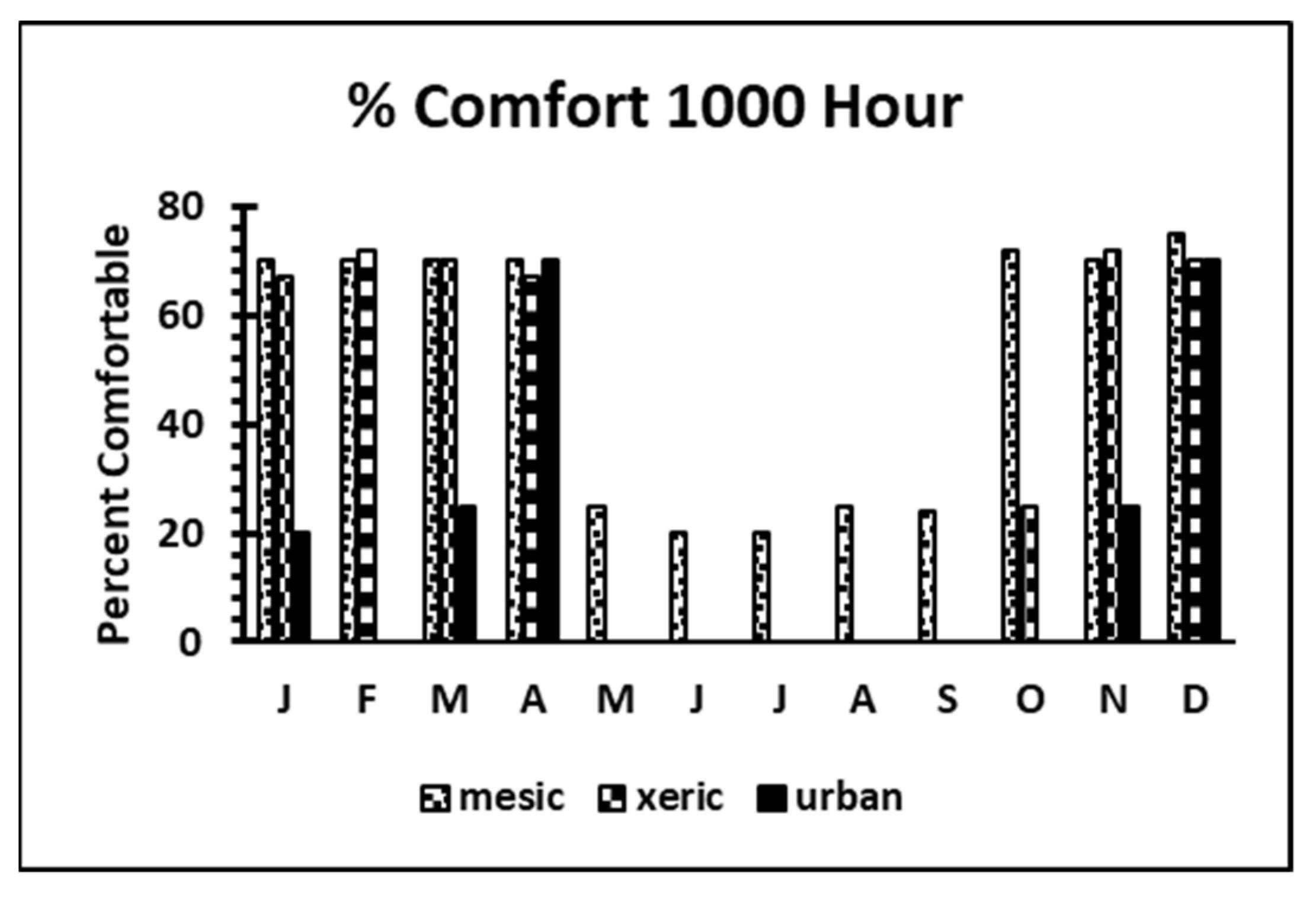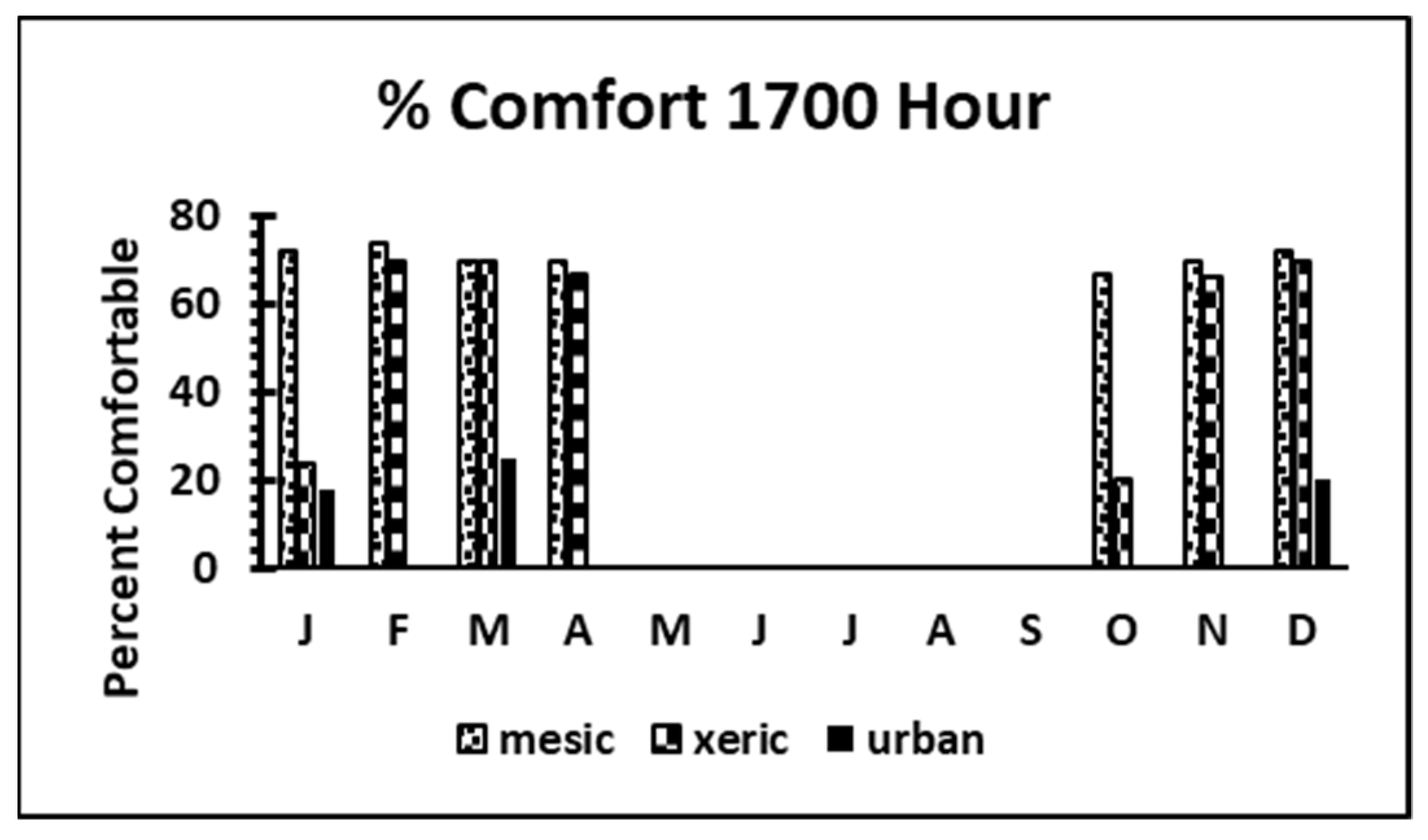Cooling Effects and Human Comfort of Constructed Wetlands in Desert Cities: A Case Study of Avondale, Arizona
Abstract
1. Introduction
2. Materials and Methodology
2.1. Study Area
2.2. Monitoring and Measurements
3. Results
3.1. Overall Mean Air Temperature (Tair)
3.2. Air Temperatures and Mean Radiant Temperature at Lake Exposed Sites and in the Dry Neighborhood
4. Discussion
5. Conclusions
Author Contributions
Funding
Institutional Review Board Statement
Informed Consent Statement
Data Availability Statement
Acknowledgments
Conflicts of Interest
References
- Voogt, J.A. Urban Heat Islands: Hotter Cities. Am. Inst. Biol. Sci. 2004, 1–2. [Google Scholar]
- Wilson, B. Urban Heat Management and the Legacy of Redlining. J. Am. Plann. Assoc. 2020, 86, 443–457. [Google Scholar] [CrossRef]
- Cordova Saez, K. Impacts of thermal islands or urban heat islands, on the environment and human health: Comparative seasonal analysis: Caracas, October-2009, March-2010. Terra 2011, 27, 95–122. [Google Scholar]
- Fadhil, M.; Hamoodi, M.N.; Ziboon, A.R.T. Mitigating urban heat island effects in urban environments: Strategies and tools. IOP Conf. Ser. Earth Environ. Sci. 2023, 1129, 012025. [Google Scholar] [CrossRef]
- Reeve, K.; Kingston, R. Green Works for Climate Resilience: A Guide to Community Planning for Climate Change; National Wildlife Federation: Washington, DC, USA, 2014. [Google Scholar]
- Li, Z.L.; Wu, H.; Duan, S.B.; Zhao, W.; Ren, H.; Liu, X.; Zhou, C. Satellite remote sensing of global land surface temperature: Definition, methods, products, and applications. Rev. Geophys. 2023, 61, e2022RG000777. [Google Scholar] [CrossRef]
- Murphy-Greene, C.; Brown, M.A. Climate Justice and Vulnerable Populations. In Environmental Justice and Resiliency in an Age of Uncertainty; Routledge: New York, NY, USA, 2022; pp. 14–35. [Google Scholar]
- Arizona Department of Health Services. Heat-Related Illness Emergency Department & Inpatient Admissions in Arizona by Year (2017–2021)”. ADHS. 2022. Available online: https://www.azdhs.gov/documents/preparedness/epidemiology-disease-control/extreme-weather/pubs/heat-related-illness-emergency-department-and-inpatient-admissions-in-arizona-by-year.pdf (accessed on 23 April 2022).
- Ban-Weiss, G.A.; Bala, G.; Cao, L.; Pongratz, J.; Caldeira, K. Climate forcing and response to idealized changes in surface latent and sensible heat. Environ. Res. Lett. 2011, 6, 034032. [Google Scholar] [CrossRef]
- Iverson, S.A.; Gettel, A.; Bezold, C.P.; Goodin, K.; McKinney, B.; Sunenshine, R.; Berisha, V. Heat-associated mortality in a hot climate: Maricopa County, Arizona, 2006–2016. Public Health Rep. 2020, 135, 631–639. [Google Scholar] [CrossRef]
- Arizona Department of Health Services. Heat-Caused & Heat-Related Deaths in Arizona by Year (2011–2021)”. AZDHS. 2023. Available online: https://www.azdhs.gov/documents/preparedness/epidemiology-disease-control/extreme-weather/pubs/heat-related-mortality-year.pdf (accessed on 21 April 2024).
- Lewis, O.V.; LaRoche, P.; Hutchison, J.-M.; Ponce, A. Understanding Efficient Mitigation Strategies for Los Angeles’ Heat Islands using OLS Regression Analysis. 2022. Available online: http://www.arcc-arch.org/wp-content/uploads/2022/05/Lewis-Olivia-Vander-Poel-La-Roche-Pablo-Hutchison-Joey-Michelle-Ponce-Arianne_Understanding-Efficient-Mitigation-Strategies-for-Los-Angeles-Heat-Islands-using-OLS-Regression-Analysis.pdf (accessed on 21 April 2024).
- Bosch, M. A spatially-explicit approach to simulate urban heat islands in complex urban landscapes. Geosci. Model Dev. Discuss. 2021, 14, 3521–3537. [Google Scholar] [CrossRef]
- Gianniou, S.K.; Antonopoulos, V.Z. Evaporation and energy budget in Lake Vegoritis, Greece. J. Hydrol. 2007, 345, 212–223. [Google Scholar] [CrossRef]
- Wang, Y.; Zhang, Y.; Ding, N.; Qin, K.; Yang, X. Simulating the impact of urban surface evapotranspiration on the urban heat island effect using the modified RS-PM model: A case study of Xuzhou, China. Remote Sens. 2020, 12, 578. [Google Scholar] [CrossRef]
- Sun, R.; Chen, L. How can urban water bodies be designed for climate adaptation? Landsc. Urban Plan. 2012, 105, 27–33. [Google Scholar] [CrossRef]
- Sun, R.; Chen, A.; Chen, L.; Lü, Y. Cooling effects of wetlands in an urban region: The case of Beijing. Ecol. Indic. 2012, 20, 57–64. [Google Scholar] [CrossRef]
- Zheng, H.W.; Shen, G.Q.; Song, Y.; Sun, B.; Hong, J. Neighborhood sustainability in urban renewal: An assessment framework. Environ. Plan. B Urban Anal. City Sci. 2017, 44, 903–924. [Google Scholar] [CrossRef]
- Wratten, S.D.; Sandhu, H.; Cullen, R.; Costanza, R. Ecosystem Services in Agricultural and Urban Landscapes, 152; Wiley Online Library: Hoboken, NJ, USA, 2013. [Google Scholar]
- Ruiz-Aviles, V.; Brazel, A.; Davis, J.M.; Pijawka, D. Mitigation of Urban Heat Island Effects through ‘Green Infrastructure’: Integrated Design of Constructed Wetlands and Neighborhood Development. Urban Sci. 2020, 4, 78. [Google Scholar] [CrossRef]
- Abbott, J.K.; Klaiber, H.A.; Smith, V.K. Economic Behavior, Market Signals, and Urban Ecology. Natl. Bur. Econ. Res. 2015. Available online: https://www.nber.org/system/files/working_papers/w20959/w20959.pdf (accessed on 21 April 2024).
- City of Avondale. Crystal Gardens Lakes/Wetlands. 2023. Available online: https://www.avondaleaz.gov/government/departments/public-works/water/crystal-gardens-wetlands (accessed on 21 April 2024).
- Crystal Gardens HOA. Welcome to Crystal Gardens. 2021. Available online: https://www.crystalgardenshoa.com/ (accessed on 21 April 2024).
- World Meteorological Organization. Guidance on Measuring, Modelling and Monitoring the Canopy Layer Urban Heat Island; WMO: Geneva, Switzerland, 2023. [Google Scholar]
- Stewart, I.D.; Oke, T.R. Local Climate Zones for Urban Temperature Studies. Bull. Am. Meteorol. Soc. 2012, 93, 1879–1900. [Google Scholar] [CrossRef]
- City of Tempe Weather. Available online: https://wx.tempe.gov/ (accessed on 21 April 2024).
- International Organization of Standardization. Ergonomics of the Thermal Environment—Instruments for Measuring Physical Quantities; ISO: Geneva, Switzerland, 2023. [Google Scholar]
- Brazel, A.J.; Verville, H.J.; Lougeay, R. Spatial-temporal controls on Cooling Degree Hours: An energy demand parameter. Theor. Appl. Climatol. 1993, 47, 81–92. [Google Scholar] [CrossRef]
- MesoWest. MesoWest Data. Mesowest. 2023. Available online: https://mesowest.utah.edu/ (accessed on 21 April 2024).
- Middel, A.; Krayenhoff, E.S. Micrometeorological determinants of pedestrian thermal exposure during record-breaking heat in Tempe, Arizona: Introducing the MaRTy observational platform. Sci. Total Environ. 2019, 687, 137–151. [Google Scholar] [CrossRef] [PubMed]
- Hartz, D.A.; Brazel, A.J.; Heisler, G.M. A case study in resort climatology of Phoenix, Arizona, USA. Int. J. Biometeorol. 2006, 51, 73–83. [Google Scholar] [CrossRef]
- Yu, Z.; Yang, G.; Zuo, S.; Jørgensen, G.; Koga, M.; Vejre, H. Critical review on the cooling effect of urban blue-green space: A threshold-size perspective. Urban For. Urban Green. 2020, 49, 126630. [Google Scholar] [CrossRef]
- Heisler, G.M.; Wang, Y. Applications of a human thermal comfort model. In Proceedings of the Fourth Symposium on the Urban Environment, Norfolk, VA, USA, 19–24 May 2002; pp. 70–71. [Google Scholar]
- Davis, J.; Hagen, B.; Mahid, Y.; Pijawka, D. Evaluating Property Value Impact from Water-Related ‘Green Infrastructure’: A Hedonic Modeling Approach. J. Green Build. 2023, 18, 3–16. [Google Scholar] [CrossRef]






| Sensor | Variable (s) | Range | Accuracy | Height |
|---|---|---|---|---|
| Kestrel 4400 | Air temperature | −10 to +55 °C | ±0.5 °C | 1.1 m |
| Relative humidity | 0 to 100% RH | ±3.0% RH | ||
| Globe temperature | −10 to +55 °C | ±1.4 °C | ||
| Tmrt | See Equation (2) | ±0.7 °C | ||
| Wind speed | 0.6 to 60.0 ms−1 | Largest of 3% of reading, least significant digit, or 20 ft/min | ||
| DeltaTRAK 15002 | Surface temperature | −40 to 510 °C | ±2.0 °C | 1.1 m |
| Neighborhood | Tair (°C) | |
|---|---|---|
| NCG | Mean | 37.9 |
| N (# of data points) | 27 | |
| Std Dev | 2.99 | |
| SCG | Mean | 38.7 |
| N | 27 | |
| Std Dev | 2.63 | |
| CP | Mean | 38.9 |
| N | 27 |
| Mean | t Value | Sig. | |
|---|---|---|---|
| NCG-CP | −0.98 | −2.012 | 0.05 |
| SCG-CP | −0.14 | −0.237 | Not sig. |
Disclaimer/Publisher’s Note: The statements, opinions and data contained in all publications are solely those of the individual author(s) and contributor(s) and not of MDPI and/or the editor(s). MDPI and/or the editor(s) disclaim responsibility for any injury to people or property resulting from any ideas, methods, instructions or products referred to in the content. |
© 2024 by the authors. Licensee MDPI, Basel, Switzerland. This article is an open access article distributed under the terms and conditions of the Creative Commons Attribution (CC BY) license (https://creativecommons.org/licenses/by/4.0/).
Share and Cite
Brazel, A.; Ruiz-Aviles, V.; Hagen, B.; Davis, J.M.; Pijawka, D. Cooling Effects and Human Comfort of Constructed Wetlands in Desert Cities: A Case Study of Avondale, Arizona. Sustainability 2024, 16, 5456. https://doi.org/10.3390/su16135456
Brazel A, Ruiz-Aviles V, Hagen B, Davis JM, Pijawka D. Cooling Effects and Human Comfort of Constructed Wetlands in Desert Cities: A Case Study of Avondale, Arizona. Sustainability. 2024; 16(13):5456. https://doi.org/10.3390/su16135456
Chicago/Turabian StyleBrazel, Anthony, Victor Ruiz-Aviles, Bjoern Hagen, Jonathan M. Davis, and David Pijawka. 2024. "Cooling Effects and Human Comfort of Constructed Wetlands in Desert Cities: A Case Study of Avondale, Arizona" Sustainability 16, no. 13: 5456. https://doi.org/10.3390/su16135456
APA StyleBrazel, A., Ruiz-Aviles, V., Hagen, B., Davis, J. M., & Pijawka, D. (2024). Cooling Effects and Human Comfort of Constructed Wetlands in Desert Cities: A Case Study of Avondale, Arizona. Sustainability, 16(13), 5456. https://doi.org/10.3390/su16135456







